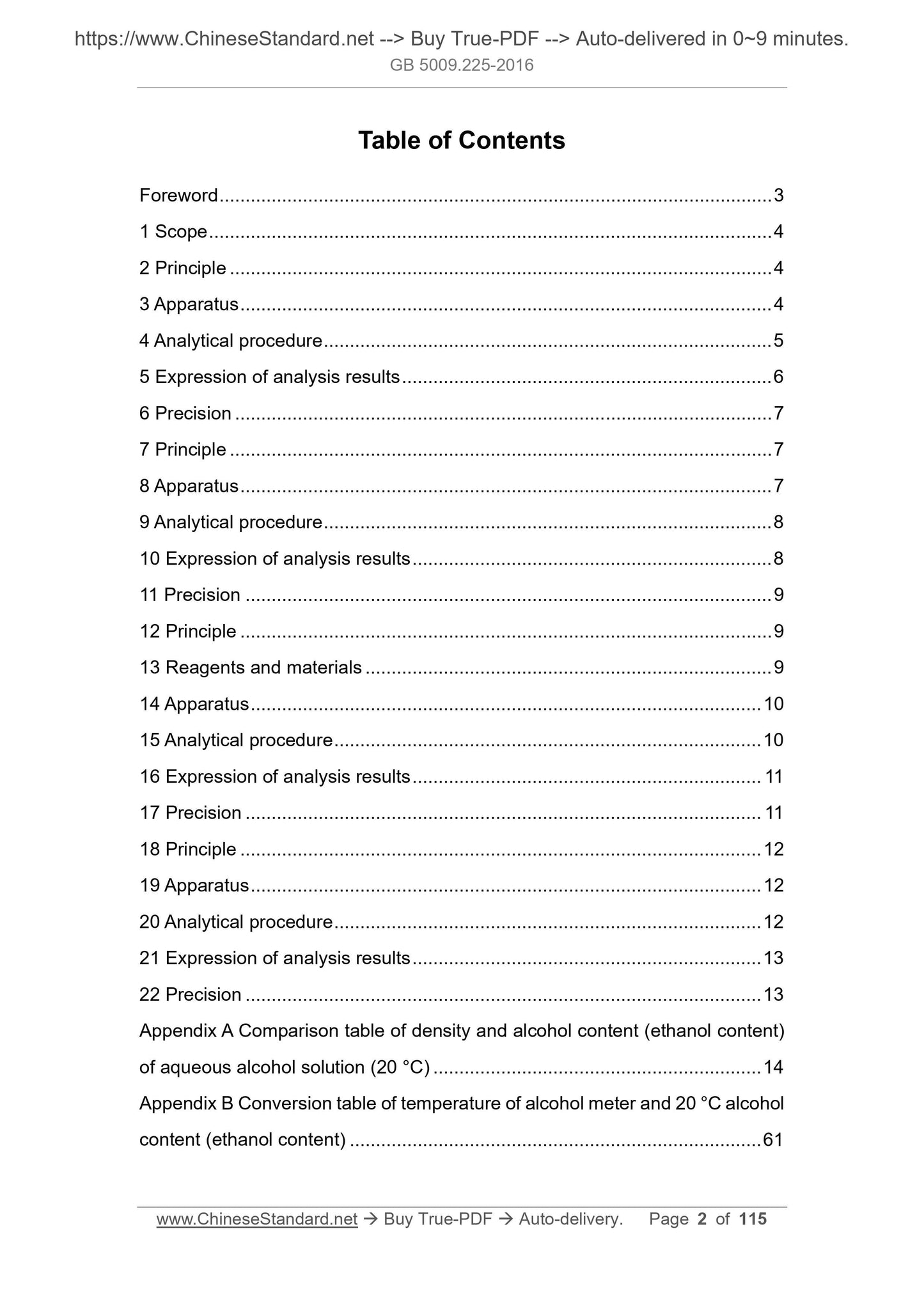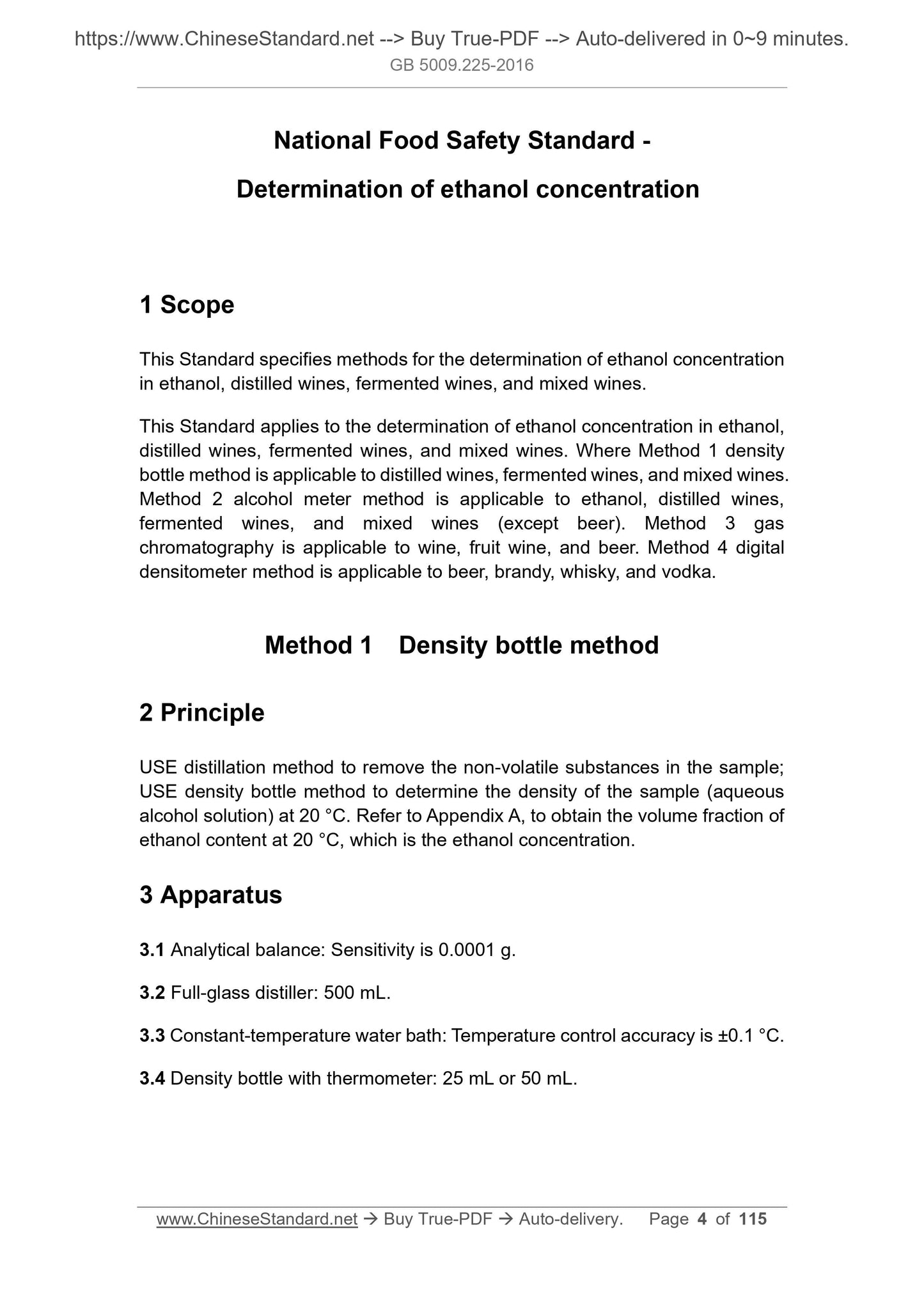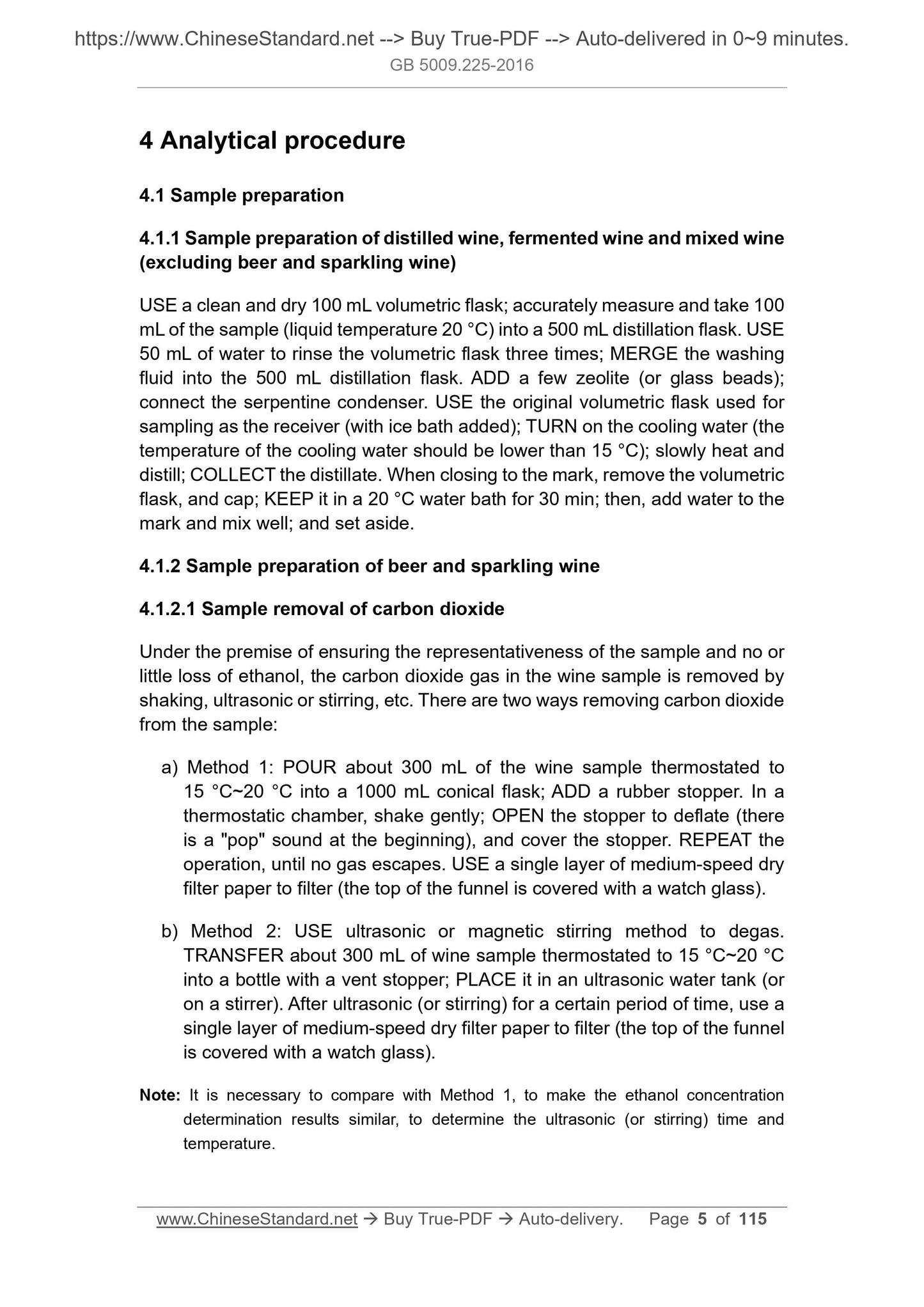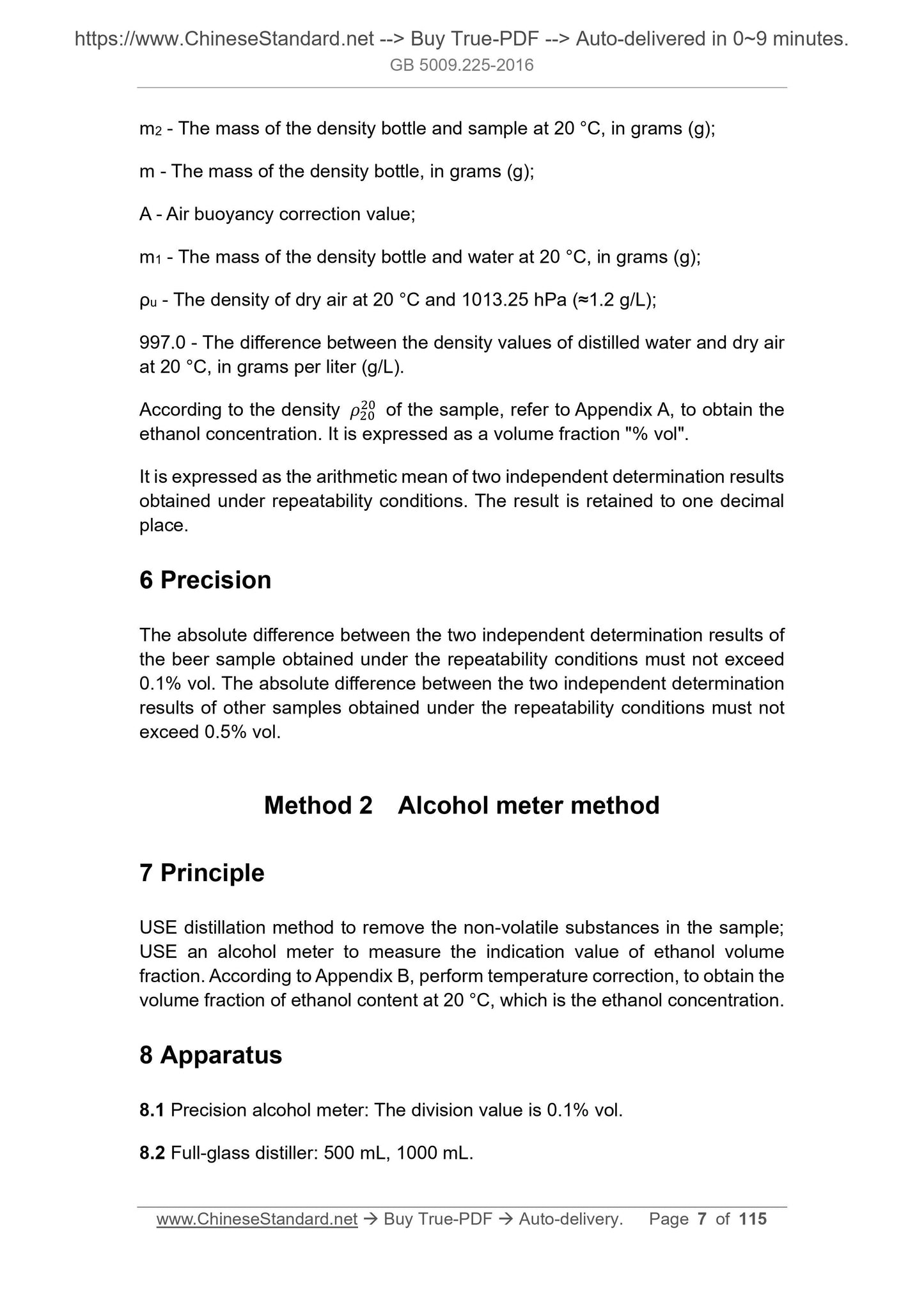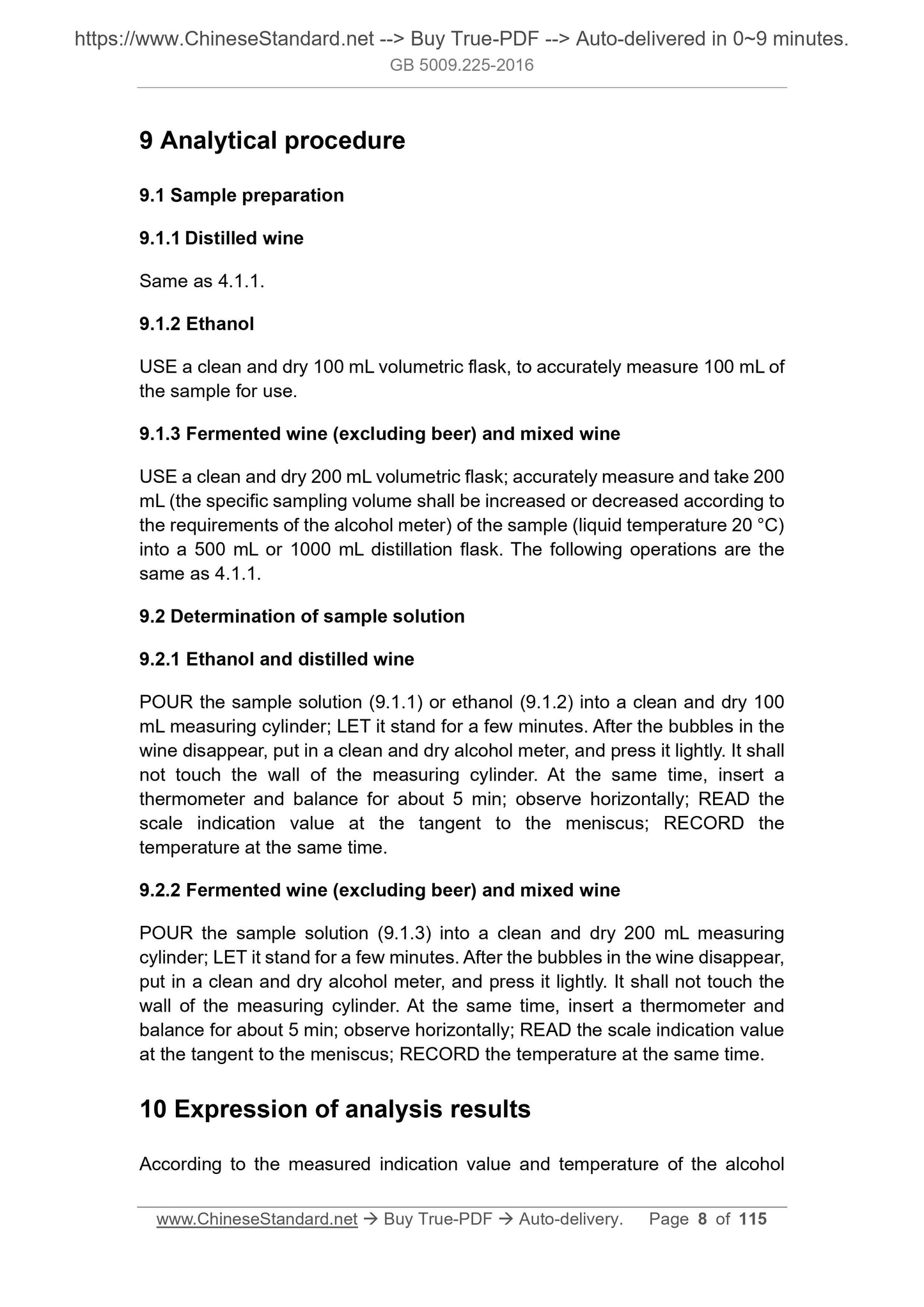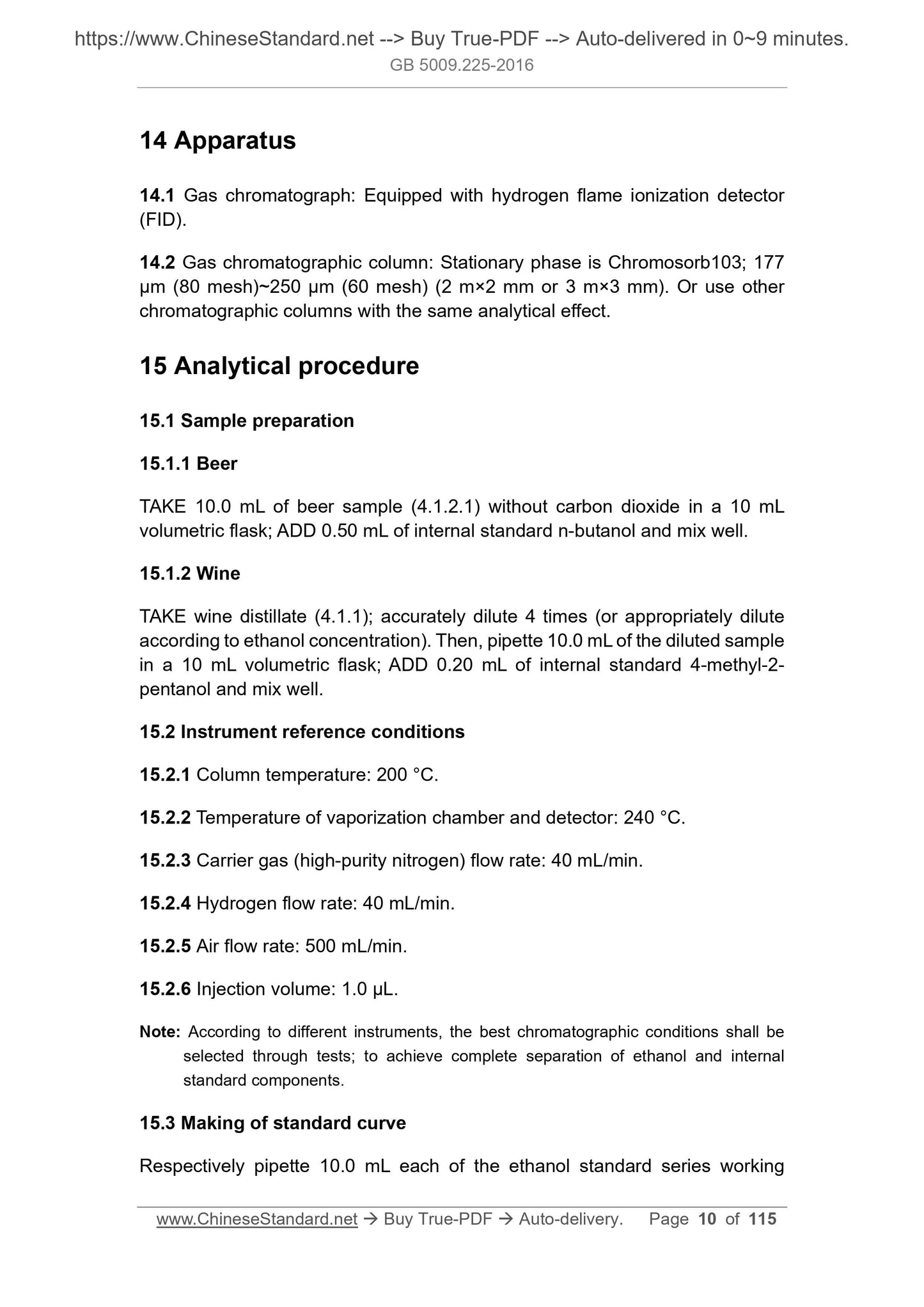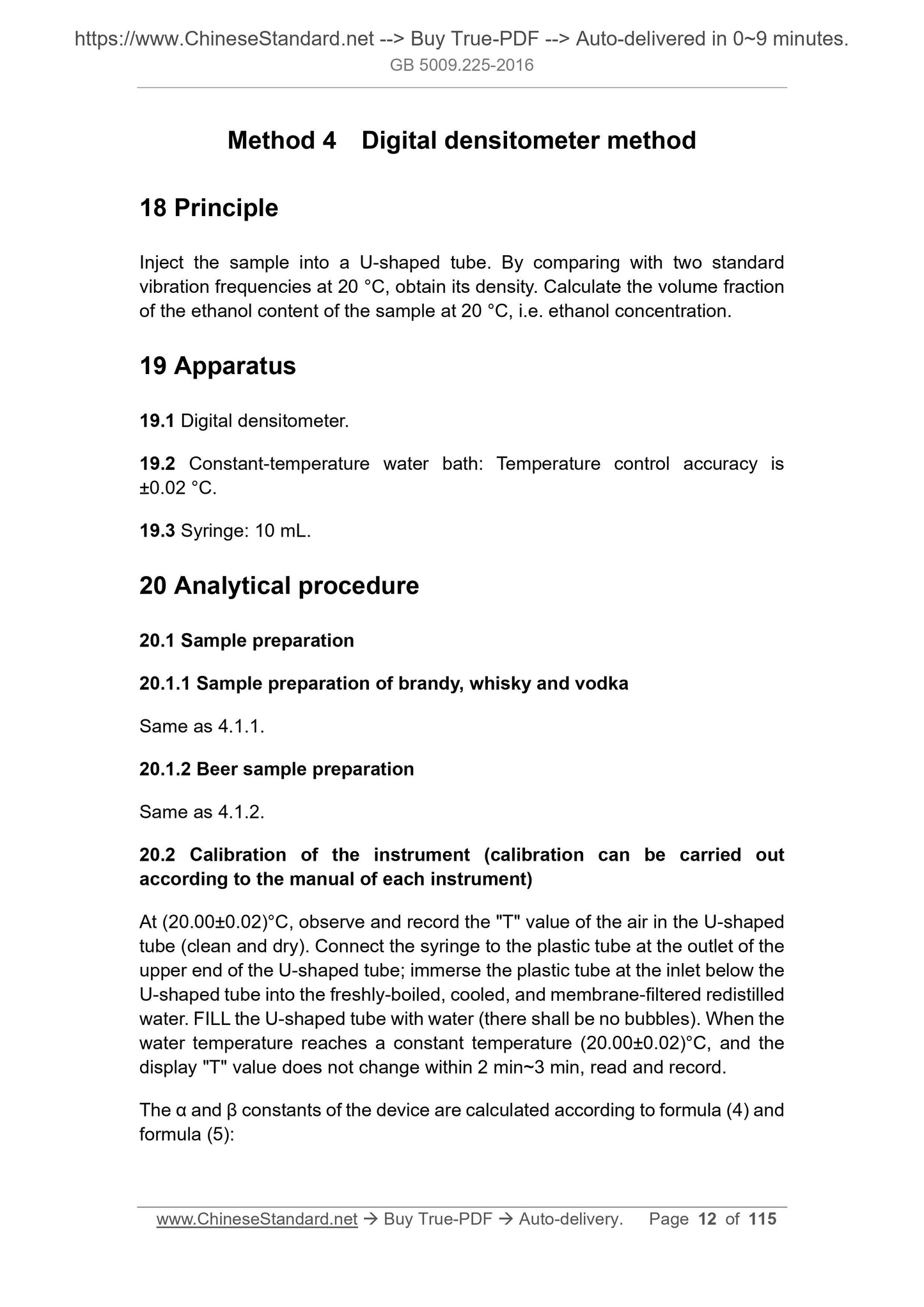1
/
of
8
www.ChineseStandard.us -- Field Test Asia Pte. Ltd.
GB 5009.225-2016 English PDF
GB 5009.225-2016 English PDF
Regular price
$1,310.00
Regular price
Sale price
$1,310.00
Unit price
/
per
Shipping calculated at checkout.
Couldn't load pickup availability
GB 5009.225-2016: National Food Safety Standard -- Determination of ethanol concentration
Delivery: 9 seconds. Download (& Email) true-PDF + Invoice.
Get Quotation: Click GB 5009.225-2016 (Self-service in 1-minute)
Historical versions (Master-website): GB 5009.225-2016
Preview True-PDF (Reload/Scroll-down if blank)
>GB 5009.225-2016
GB
NATIONAL STANDARD OF THE
PEOPLE’S REPUBLIC OF CHINA
National Food Safety Standard -
Determination of ethanol concentration
ISSUED ON: AUGUST 31, 2016
IMPLEMENTED ON: MARCH 01, 2017
Issued by: National Health and Family Planning Commission of the PRC
Table of Contents
Foreword ... 3
1 Scope ... 4
2 Principle ... 4
3 Apparatus ... 4
4 Analytical procedure ... 5
5 Expression of analysis results ... 6
6 Precision ... 7
7 Principle ... 7
8 Apparatus ... 7
9 Analytical procedure ... 8
10 Expression of analysis results ... 8
11 Precision ... 9
12 Principle ... 9
13 Reagents and materials ... 9
14 Apparatus ... 10
15 Analytical procedure ... 10
16 Expression of analysis results ... 11
17 Precision ... 11
18 Principle ... 12
19 Apparatus ... 12
20 Analytical procedure ... 12
21 Expression of analysis results ... 13
22 Precision ... 13
Appendix A Comparison table of density and alcohol content (ethanol content)
of aqueous alcohol solution (20 °C) ... 14
Appendix B Conversion table of temperature of alcohol meter and 20 °C alcohol
content (ethanol content) ... 61
National Food Safety Standard -
Determination of ethanol concentration
1 Scope
This Standard specifies methods for the determination of ethanol concentration
in ethanol, distilled wines, fermented wines, and mixed wines.
This Standard applies to the determination of ethanol concentration in ethanol,
distilled wines, fermented wines, and mixed wines. Where Method 1 density
bottle method is applicable to distilled wines, fermented wines, and mixed wines.
Method 2 alcohol meter method is applicable to ethanol, distilled wines,
fermented wines, and mixed wines (except beer). Method 3 gas
chromatography is applicable to wine, fruit wine, and beer. Method 4 digital
densitometer method is applicable to beer, brandy, whisky, and vodka.
Method 1 Density bottle method
2 Principle
USE distillation method to remove the non-volatile substances in the sample;
USE density bottle method to determine the density of the sample (aqueous
alcohol solution) at 20 °C. Refer to Appendix A, to obtain the volume fraction of
ethanol content at 20 °C, which is the ethanol concentration.
3 Apparatus
3.1 Analytical balance: Sensitivity is 0.0001 g.
3.2 Full-glass distiller: 500 mL.
3.3 Constant-temperature water bath: Temperature control accuracy is ±0.1 °C.
3.4 Density bottle with thermometer: 25 mL or 50 mL.
4 Analytical procedure
4.1 Sample preparation
4.1.1 Sample preparation of distilled wine, fermented wine and mixed wine
(excluding beer and sparkling wine)
USE a clean and dry 100 mL volumetric flask; accurately measure and take 100
mL of the sample (liquid temperature 20 °C) into a 500 mL distillation flask. USE
50 mL of water to rinse the volumetric flask three times; MERGE the washing
fluid into the 500 mL distillation flask. ADD a few zeolite (or glass beads);
connect the serpentine condenser. USE the original volumetric flask used for
sampling as the receiver (with ice bath added); TURN on the cooling water (the
temperature of the cooling water should be lower than 15 °C); slowly heat and
distill; COLLECT the distillate. When closing to the mark, remove the volumetric
flask, and cap; KEEP it in a 20 °C water bath for 30 min; then, add water to the
mark and mix well; and set aside.
4.1.2 Sample preparation of beer and sparkling wine
4.1.2.1 Sample removal of carbon dioxide
Under the premise of ensuring the representativeness of the sample and no or
little loss of ethanol, the carbon dioxide gas in the wine sample is removed by
shaking, ultrasonic or stirring, etc. There are two ways removing carbon dioxide
from the sample:
a) Method 1: POUR about 300 mL of the wine sample thermostated to
15 °C~20 °C into a 1000 mL conical flask; ADD a rubber stopper. In a
thermostatic chamber, shake gently; OPEN the stopper to deflate (there
is a "pop" sound at the beginning), and cover the stopper. REPEAT the
operation, until no gas escapes. USE a single layer of medium-speed dry
filter paper to filter (the top of the funnel is covered with a watch glass).
b) Method 2: USE ultrasonic or magnetic stirring method to degas.
TRANSFER about 300 mL of wine sample thermostated to 15 °C~20 °C
into a bottle with a vent stopper; PLACE it in an ultrasonic water tank (or
on a stirrer). After ultrasonic (or stirring) for a certain period of time, use a
single layer of medium-speed dry filter paper to filter (the top of the funnel
is covered with a watch glass).
Note: It is necessary to compare with Method 1, to make the ethanol concentration
determination results similar, to determine the ultrasonic (or stirring) time and
temperature.
m2 - The mass of the density bottle and sample at 20 °C, in grams (g);
m - The mass of the density bottle, in grams (g);
A - Air buoyancy correction value;
m1 - The mass of the density bottle and water at 20 °C, in grams (g);
ρu - The density of dry air at 20 °C and 1013.25 hPa (≈1.2 g/L);
997.0 - The difference between the density values of distilled water and dry air
at 20 °C, in grams per liter (g/L).
According to the density 𝜌ଶଶ of the sample, refer to Appendix A, to obtain the
ethanol concentration. It is expressed as a volume fraction "% vol".
It is expressed as the arithmetic mean of two independent determination results
obtained under repeatability conditions. The result is retained to one decimal
place.
6 Precision
The absolute difference between the two independent determination results of
the beer sample obtained under the repeatability conditions must not exceed
0.1% vol. The absolute difference between the two independent determination
results of other samples obtained under the repeatability conditions must not
exceed 0.5% vol.
Method 2 Alcohol meter method
7 Principle
USE distillation method to remove the non-volatile substances in the sample;
USE an alcohol meter to measure the indication value of ethanol volume
fraction. According to Appendix B, perform temperature correction, to obtain the
volume fraction of ethanol content at 20 °C, which is the ethanol concentration.
8 Apparatus
8.1 Precision alcohol meter: The division value is 0.1% vol.
8.2 Full-glass distiller: 500 mL, 1000 mL.
9 Analytical procedure
9.1 Sample preparation
9.1.1 Distilled wine
Same as 4.1.1.
9.1.2 Ethanol
USE a clean and dry 100 mL volumetric flask, to accurately measure 100 mL of
the sample for use.
9.1.3 Fermented wine (excluding beer) and mixed wine
USE a clean and dry 200 mL volumetric flask; accurately measure and take 200
mL (the specific sampling volume shall be increased or decreased according to
the requirements of the alcohol meter) of the sample (liquid temperature 20 °C)
into a 500 mL or 1000 mL distillation flask. The following operations are the
same as 4.1.1.
9.2 Determination of sample solution
9.2.1 Ethanol and distilled wine
POUR the sample solution (9.1.1) or ethanol (9.1.2) into a clean and dry 100
mL measuring cylinder; LET it stand for a few minutes. After the bubbles in the
wine disappear, put in a clean and dry alcohol meter, and press it lightly. It shall
not touch the wall of the measuring cylinder. At the same time, insert a
thermometer and balance for about 5 min; observe horizontally; READ the
scale indication value at the tangent to the meniscus; RECORD the
temperature at the same time.
9.2.2 Fermented wine (excluding beer) and mixed wine
POUR the sample solution (9.1.3) into a clean and dry 200 mL measuring
cylinder; LET it stand for a few minutes. After the bubbles in the wine disappear,
put in a clean and dry alcohol meter, and press it lightly. It shall not touch the
wall of the measuring cylinder. At the same time, insert a thermometer and
balance for about 5 min; observe horizontally; READ the scale indication value
at the tangent to the meniscus; RECORD the temperature at the same time.
10 Expression of analysis results
According to the measured indication value and temperature of the alcohol
14 Apparatus
14.1 Gas chromatograph: Equipped with hydrogen flame ionization detector
(FID).
14.2 Gas chromatographic column: Stationary phase is Chromosorb103; 177
μm (80 mesh)~250 μm (60 mesh) (2 m×2 mm or 3 m×3 mm). Or use other
chromatographic columns with the same analytical effect.
15 Analytical procedure
15.1 Sample preparation
15.1.1 Beer
TAKE 10.0 mL of beer sample (4.1.2.1) without carbon dioxide in a 10 mL
volumetric flask; ADD 0.50 mL of internal standard n-butanol and mix well.
15.1.2 Wine
TAKE wine distillate (4.1.1); accurately dilute 4 times (or appropriately dilute
according to ethanol concentration). Then, pipette 10.0 mL of the diluted sample
in a 10 mL volumetric flask; ADD 0.20 mL of internal standard 4-methyl-2-
pentanol and mix well.
15.2 Instrument reference conditions
15.2.1 Column temperature: 200 °C.
15.2.2 Temperature of vaporization chamber and detector: 240 °C.
15.2.3 Carrier gas (high-purity nitrogen) flow rate: 40 mL/min.
15.2.4 Hydrogen flow rate: 40 mL/min.
15.2.5 Air flow rate: 500 mL/min.
15.2.6 Injection volume: 1.0 μL.
Note: According to different instruments, the best chromatographic conditions shall be
selected through tests; to achieve complete separation of ethanol and internal
standard components.
15.3 Making of standard curve
Respectively pipette 10.0 mL each of the ethanol standard series working
Method 4 Digital densitometer method
18 Principle
Inject the sample into a U-shaped tube. By comparing with two standard
vibration frequencies at 20 °C, obtain its density. Calculate the volume fraction
of the ethanol content of the sample at 20 °C, i.e. ethanol concentration.
19 Apparatus
19.1 Digital densitometer.
19.2 Constant-temperature water bath: Temperature control accuracy is
±0.02 °C.
19.3 Syringe: 10 mL.
20 Analytical procedure
20.1 Sample preparation
20.1.1 Sample preparation of brandy, whisky and vodka
Same as 4.1.1.
20.1.2 Beer sample preparation
Same as 4.1.2.
20.2 Calibration of the instrument (calibration can be carried out
according to the manual of each instrument)
At (20.00±0.02)°C, observe and record the "T" value of the air in the U-shaped
tube (clean and dry). Connect the syringe to the plastic tube at the outlet of the
upper end of the U-shaped tube; immerse the plastic tube at the inlet below the
U-shaped tube into the freshly-boiled, cooled, and membrane-filtered redistilled
water. FILL the U-shaped tube with water (there shall be no bubbles). When the
water temperature reaches a constant temperature (20.00±0.02)°C, and the
display "T" value does not change within 2 min~3 min, read and record.
The α and β constants of the device are calculated according to formula (4) and
formula (5):
GB 5009.225-2016
GB
NATIONAL STANDARD OF THE
PEOPLE’S REPUBLIC OF CHINA
National Food Safety Standard -
Determination of ethanol concentration
ISSUED ON: AUGUST 31, 2016
IMPLEMENTED ON: MARCH 01, 2017
Issued by: National Health and Family Planning Commission of the PRC
Table of Contents
Foreword ... 3
1 Scope ... 4
2 Principle ... 4
3 Apparatus ... 4
4 Analytical procedure ... 5
5 Expression of analysis results ... 6
6 Precision ... 7
7 Principle ... 7
8 Apparatus ... 7
9 Analytical procedure ... 8
10 Expression of analysis results ... 8
11 Precision ... 9
12 Principle ... 9
13 Reagents and materials ... 9
14 Apparatus ... 10
15 Analytical procedure ... 10
16 Expression of analysis results ... 11
17 Precision ... 11
18 Principle ... 12
19 Apparatus ... 12
20 Analytical procedure ... 12
21 Expression of analysis results ... 13
22 Precision ... 13
Appendix A Comparison table of density and alcohol content (ethanol content)
of aqueous alcohol solution (20 °C) ... 14
Appendix B Conversion table of temperature of alcohol meter and 20 °C alcohol
content (ethanol content) ... 61
National Food Safety Standard -
Determination of ethanol concentration
1 Scope
This Standard specifies methods for the determination of ethanol concentration
in ethanol, distilled wines, fermented wines, and mixed wines.
This Standard applies to the determination of ethanol concentration in ethanol,
distilled wines, fermented wines, and mixed wines. Where Method 1 density
bottle method is applicable to distilled wines, fermented wines, and mixed wines.
Method 2 alcohol meter method is applicable to ethanol, distilled wines,
fermented wines, and mixed wines (except beer). Method 3 gas
chromatography is applicable to wine, fruit wine, and beer. Method 4 digital
densitometer method is applicable to beer, brandy, whisky, and vodka.
Method 1 Density bottle method
2 Principle
USE distillation method to remove the non-volatile substances in the sample;
USE density bottle method to determine the density of the sample (aqueous
alcohol solution) at 20 °C. Refer to Appendix A, to obtain the volume fraction of
ethanol content at 20 °C, which is the ethanol concentration.
3 Apparatus
3.1 Analytical balance: Sensitivity is 0.0001 g.
3.2 Full-glass distiller: 500 mL.
3.3 Constant-temperature water bath: Temperature control accuracy is ±0.1 °C.
3.4 Density bottle with thermometer: 25 mL or 50 mL.
4 Analytical procedure
4.1 Sample preparation
4.1.1 Sample preparation of distilled wine, fermented wine and mixed wine
(excluding beer and sparkling wine)
USE a clean and dry 100 mL volumetric flask; accurately measure and take 100
mL of the sample (liquid temperature 20 °C) into a 500 mL distillation flask. USE
50 mL of water to rinse the volumetric flask three times; MERGE the washing
fluid into the 500 mL distillation flask. ADD a few zeolite (or glass beads);
connect the serpentine condenser. USE the original volumetric flask used for
sampling as...
Delivery: 9 seconds. Download (& Email) true-PDF + Invoice.
Get Quotation: Click GB 5009.225-2016 (Self-service in 1-minute)
Historical versions (Master-website): GB 5009.225-2016
Preview True-PDF (Reload/Scroll-down if blank)
>GB 5009.225-2016
GB
NATIONAL STANDARD OF THE
PEOPLE’S REPUBLIC OF CHINA
National Food Safety Standard -
Determination of ethanol concentration
ISSUED ON: AUGUST 31, 2016
IMPLEMENTED ON: MARCH 01, 2017
Issued by: National Health and Family Planning Commission of the PRC
Table of Contents
Foreword ... 3
1 Scope ... 4
2 Principle ... 4
3 Apparatus ... 4
4 Analytical procedure ... 5
5 Expression of analysis results ... 6
6 Precision ... 7
7 Principle ... 7
8 Apparatus ... 7
9 Analytical procedure ... 8
10 Expression of analysis results ... 8
11 Precision ... 9
12 Principle ... 9
13 Reagents and materials ... 9
14 Apparatus ... 10
15 Analytical procedure ... 10
16 Expression of analysis results ... 11
17 Precision ... 11
18 Principle ... 12
19 Apparatus ... 12
20 Analytical procedure ... 12
21 Expression of analysis results ... 13
22 Precision ... 13
Appendix A Comparison table of density and alcohol content (ethanol content)
of aqueous alcohol solution (20 °C) ... 14
Appendix B Conversion table of temperature of alcohol meter and 20 °C alcohol
content (ethanol content) ... 61
National Food Safety Standard -
Determination of ethanol concentration
1 Scope
This Standard specifies methods for the determination of ethanol concentration
in ethanol, distilled wines, fermented wines, and mixed wines.
This Standard applies to the determination of ethanol concentration in ethanol,
distilled wines, fermented wines, and mixed wines. Where Method 1 density
bottle method is applicable to distilled wines, fermented wines, and mixed wines.
Method 2 alcohol meter method is applicable to ethanol, distilled wines,
fermented wines, and mixed wines (except beer). Method 3 gas
chromatography is applicable to wine, fruit wine, and beer. Method 4 digital
densitometer method is applicable to beer, brandy, whisky, and vodka.
Method 1 Density bottle method
2 Principle
USE distillation method to remove the non-volatile substances in the sample;
USE density bottle method to determine the density of the sample (aqueous
alcohol solution) at 20 °C. Refer to Appendix A, to obtain the volume fraction of
ethanol content at 20 °C, which is the ethanol concentration.
3 Apparatus
3.1 Analytical balance: Sensitivity is 0.0001 g.
3.2 Full-glass distiller: 500 mL.
3.3 Constant-temperature water bath: Temperature control accuracy is ±0.1 °C.
3.4 Density bottle with thermometer: 25 mL or 50 mL.
4 Analytical procedure
4.1 Sample preparation
4.1.1 Sample preparation of distilled wine, fermented wine and mixed wine
(excluding beer and sparkling wine)
USE a clean and dry 100 mL volumetric flask; accurately measure and take 100
mL of the sample (liquid temperature 20 °C) into a 500 mL distillation flask. USE
50 mL of water to rinse the volumetric flask three times; MERGE the washing
fluid into the 500 mL distillation flask. ADD a few zeolite (or glass beads);
connect the serpentine condenser. USE the original volumetric flask used for
sampling as the receiver (with ice bath added); TURN on the cooling water (the
temperature of the cooling water should be lower than 15 °C); slowly heat and
distill; COLLECT the distillate. When closing to the mark, remove the volumetric
flask, and cap; KEEP it in a 20 °C water bath for 30 min; then, add water to the
mark and mix well; and set aside.
4.1.2 Sample preparation of beer and sparkling wine
4.1.2.1 Sample removal of carbon dioxide
Under the premise of ensuring the representativeness of the sample and no or
little loss of ethanol, the carbon dioxide gas in the wine sample is removed by
shaking, ultrasonic or stirring, etc. There are two ways removing carbon dioxide
from the sample:
a) Method 1: POUR about 300 mL of the wine sample thermostated to
15 °C~20 °C into a 1000 mL conical flask; ADD a rubber stopper. In a
thermostatic chamber, shake gently; OPEN the stopper to deflate (there
is a "pop" sound at the beginning), and cover the stopper. REPEAT the
operation, until no gas escapes. USE a single layer of medium-speed dry
filter paper to filter (the top of the funnel is covered with a watch glass).
b) Method 2: USE ultrasonic or magnetic stirring method to degas.
TRANSFER about 300 mL of wine sample thermostated to 15 °C~20 °C
into a bottle with a vent stopper; PLACE it in an ultrasonic water tank (or
on a stirrer). After ultrasonic (or stirring) for a certain period of time, use a
single layer of medium-speed dry filter paper to filter (the top of the funnel
is covered with a watch glass).
Note: It is necessary to compare with Method 1, to make the ethanol concentration
determination results similar, to determine the ultrasonic (or stirring) time and
temperature.
m2 - The mass of the density bottle and sample at 20 °C, in grams (g);
m - The mass of the density bottle, in grams (g);
A - Air buoyancy correction value;
m1 - The mass of the density bottle and water at 20 °C, in grams (g);
ρu - The density of dry air at 20 °C and 1013.25 hPa (≈1.2 g/L);
997.0 - The difference between the density values of distilled water and dry air
at 20 °C, in grams per liter (g/L).
According to the density 𝜌ଶଶ of the sample, refer to Appendix A, to obtain the
ethanol concentration. It is expressed as a volume fraction "% vol".
It is expressed as the arithmetic mean of two independent determination results
obtained under repeatability conditions. The result is retained to one decimal
place.
6 Precision
The absolute difference between the two independent determination results of
the beer sample obtained under the repeatability conditions must not exceed
0.1% vol. The absolute difference between the two independent determination
results of other samples obtained under the repeatability conditions must not
exceed 0.5% vol.
Method 2 Alcohol meter method
7 Principle
USE distillation method to remove the non-volatile substances in the sample;
USE an alcohol meter to measure the indication value of ethanol volume
fraction. According to Appendix B, perform temperature correction, to obtain the
volume fraction of ethanol content at 20 °C, which is the ethanol concentration.
8 Apparatus
8.1 Precision alcohol meter: The division value is 0.1% vol.
8.2 Full-glass distiller: 500 mL, 1000 mL.
9 Analytical procedure
9.1 Sample preparation
9.1.1 Distilled wine
Same as 4.1.1.
9.1.2 Ethanol
USE a clean and dry 100 mL volumetric flask, to accurately measure 100 mL of
the sample for use.
9.1.3 Fermented wine (excluding beer) and mixed wine
USE a clean and dry 200 mL volumetric flask; accurately measure and take 200
mL (the specific sampling volume shall be increased or decreased according to
the requirements of the alcohol meter) of the sample (liquid temperature 20 °C)
into a 500 mL or 1000 mL distillation flask. The following operations are the
same as 4.1.1.
9.2 Determination of sample solution
9.2.1 Ethanol and distilled wine
POUR the sample solution (9.1.1) or ethanol (9.1.2) into a clean and dry 100
mL measuring cylinder; LET it stand for a few minutes. After the bubbles in the
wine disappear, put in a clean and dry alcohol meter, and press it lightly. It shall
not touch the wall of the measuring cylinder. At the same time, insert a
thermometer and balance for about 5 min; observe horizontally; READ the
scale indication value at the tangent to the meniscus; RECORD the
temperature at the same time.
9.2.2 Fermented wine (excluding beer) and mixed wine
POUR the sample solution (9.1.3) into a clean and dry 200 mL measuring
cylinder; LET it stand for a few minutes. After the bubbles in the wine disappear,
put in a clean and dry alcohol meter, and press it lightly. It shall not touch the
wall of the measuring cylinder. At the same time, insert a thermometer and
balance for about 5 min; observe horizontally; READ the scale indication value
at the tangent to the meniscus; RECORD the temperature at the same time.
10 Expression of analysis results
According to the measured indication value and temperature of the alcohol
14 Apparatus
14.1 Gas chromatograph: Equipped with hydrogen flame ionization detector
(FID).
14.2 Gas chromatographic column: Stationary phase is Chromosorb103; 177
μm (80 mesh)~250 μm (60 mesh) (2 m×2 mm or 3 m×3 mm). Or use other
chromatographic columns with the same analytical effect.
15 Analytical procedure
15.1 Sample preparation
15.1.1 Beer
TAKE 10.0 mL of beer sample (4.1.2.1) without carbon dioxide in a 10 mL
volumetric flask; ADD 0.50 mL of internal standard n-butanol and mix well.
15.1.2 Wine
TAKE wine distillate (4.1.1); accurately dilute 4 times (or appropriately dilute
according to ethanol concentration). Then, pipette 10.0 mL of the diluted sample
in a 10 mL volumetric flask; ADD 0.20 mL of internal standard 4-methyl-2-
pentanol and mix well.
15.2 Instrument reference conditions
15.2.1 Column temperature: 200 °C.
15.2.2 Temperature of vaporization chamber and detector: 240 °C.
15.2.3 Carrier gas (high-purity nitrogen) flow rate: 40 mL/min.
15.2.4 Hydrogen flow rate: 40 mL/min.
15.2.5 Air flow rate: 500 mL/min.
15.2.6 Injection volume: 1.0 μL.
Note: According to different instruments, the best chromatographic conditions shall be
selected through tests; to achieve complete separation of ethanol and internal
standard components.
15.3 Making of standard curve
Respectively pipette 10.0 mL each of the ethanol standard series working
Method 4 Digital densitometer method
18 Principle
Inject the sample into a U-shaped tube. By comparing with two standard
vibration frequencies at 20 °C, obtain its density. Calculate the volume fraction
of the ethanol content of the sample at 20 °C, i.e. ethanol concentration.
19 Apparatus
19.1 Digital densitometer.
19.2 Constant-temperature water bath: Temperature control accuracy is
±0.02 °C.
19.3 Syringe: 10 mL.
20 Analytical procedure
20.1 Sample preparation
20.1.1 Sample preparation of brandy, whisky and vodka
Same as 4.1.1.
20.1.2 Beer sample preparation
Same as 4.1.2.
20.2 Calibration of the instrument (calibration can be carried out
according to the manual of each instrument)
At (20.00±0.02)°C, observe and record the "T" value of the air in the U-shaped
tube (clean and dry). Connect the syringe to the plastic tube at the outlet of the
upper end of the U-shaped tube; immerse the plastic tube at the inlet below the
U-shaped tube into the freshly-boiled, cooled, and membrane-filtered redistilled
water. FILL the U-shaped tube with water (there shall be no bubbles). When the
water temperature reaches a constant temperature (20.00±0.02)°C, and the
display "T" value does not change within 2 min~3 min, read and record.
The α and β constants of the device are calculated according to formula (4) and
formula (5):
GB 5009.225-2016
GB
NATIONAL STANDARD OF THE
PEOPLE’S REPUBLIC OF CHINA
National Food Safety Standard -
Determination of ethanol concentration
ISSUED ON: AUGUST 31, 2016
IMPLEMENTED ON: MARCH 01, 2017
Issued by: National Health and Family Planning Commission of the PRC
Table of Contents
Foreword ... 3
1 Scope ... 4
2 Principle ... 4
3 Apparatus ... 4
4 Analytical procedure ... 5
5 Expression of analysis results ... 6
6 Precision ... 7
7 Principle ... 7
8 Apparatus ... 7
9 Analytical procedure ... 8
10 Expression of analysis results ... 8
11 Precision ... 9
12 Principle ... 9
13 Reagents and materials ... 9
14 Apparatus ... 10
15 Analytical procedure ... 10
16 Expression of analysis results ... 11
17 Precision ... 11
18 Principle ... 12
19 Apparatus ... 12
20 Analytical procedure ... 12
21 Expression of analysis results ... 13
22 Precision ... 13
Appendix A Comparison table of density and alcohol content (ethanol content)
of aqueous alcohol solution (20 °C) ... 14
Appendix B Conversion table of temperature of alcohol meter and 20 °C alcohol
content (ethanol content) ... 61
National Food Safety Standard -
Determination of ethanol concentration
1 Scope
This Standard specifies methods for the determination of ethanol concentration
in ethanol, distilled wines, fermented wines, and mixed wines.
This Standard applies to the determination of ethanol concentration in ethanol,
distilled wines, fermented wines, and mixed wines. Where Method 1 density
bottle method is applicable to distilled wines, fermented wines, and mixed wines.
Method 2 alcohol meter method is applicable to ethanol, distilled wines,
fermented wines, and mixed wines (except beer). Method 3 gas
chromatography is applicable to wine, fruit wine, and beer. Method 4 digital
densitometer method is applicable to beer, brandy, whisky, and vodka.
Method 1 Density bottle method
2 Principle
USE distillation method to remove the non-volatile substances in the sample;
USE density bottle method to determine the density of the sample (aqueous
alcohol solution) at 20 °C. Refer to Appendix A, to obtain the volume fraction of
ethanol content at 20 °C, which is the ethanol concentration.
3 Apparatus
3.1 Analytical balance: Sensitivity is 0.0001 g.
3.2 Full-glass distiller: 500 mL.
3.3 Constant-temperature water bath: Temperature control accuracy is ±0.1 °C.
3.4 Density bottle with thermometer: 25 mL or 50 mL.
4 Analytical procedure
4.1 Sample preparation
4.1.1 Sample preparation of distilled wine, fermented wine and mixed wine
(excluding beer and sparkling wine)
USE a clean and dry 100 mL volumetric flask; accurately measure and take 100
mL of the sample (liquid temperature 20 °C) into a 500 mL distillation flask. USE
50 mL of water to rinse the volumetric flask three times; MERGE the washing
fluid into the 500 mL distillation flask. ADD a few zeolite (or glass beads);
connect the serpentine condenser. USE the original volumetric flask used for
sampling as...
Share

